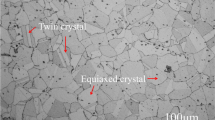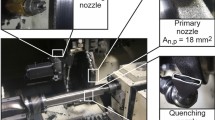Abstract
Creep-feed grinding wheels have been associated with advances in processing difficult-to-cut materials used in the aerospace industry for many years. Since the late 1960s, the development of grinding wheels used for creep-feed grinding (CFG) operations and high-efficiency deep grinding (HEDG) operations has placed great responsibility on grinding wheel manufacturers to produce bonding systems of high strength and bonding bridges with smaller cross-sectional area. The safety of grinding wheels has become very important in recent years due to the increases in porosity (~ 50% vol.) and reductions in bond content (~ 5% vol.). This has necessitated the development of very strong bonding systems that can withstand high rotational, thermal, clamping and contact stresses. The paper not only provides a review of work performed on conventional grinding wheels, but also explains how the use of computational modeling techniques are used to simulate the stresses experienced by superabrasive wheels that are used at high-speeds in creep-feed grinding (CFG), high-efficiency deep grinding (HEDG) and peel grinding (PG) processes. Superabrasive materials of choice for use on difficult-to-machine alloys are typically cubic boron nitride (cBN) and diamond bonded with a vitrified glass-ceramic bonding system. The current work also explains how Weibull statistics are used to characterize the strength of the abrasive-porosity-bond composite structure and how the computational and Weibull statistical analyses are unified through the use of a simple measure of operational integrity known as the safety factor. The paper concludes by showing the reader how computational techniques can be used to design CFG wheels by optimizing abrasive segments bonded to a reinforcing material of high strength operating at a specific peripheral speed. It should be noted that this study is applicable to multi-layered CFG wheels and not to single-layer electroplated grinding wheels that are also used in CFG operations.







Similar content being viewed by others
References
W.B. Rowe, Principles of Modern Grinding Technology, 2nd ed. Elsevier, New York, 2014, p 437
M.J. Jackson and M.P. Hitchiner, Abrasive Tools and Bonding Systems, Machining with Abrasives. M.J. Jackson, J.P. Davim Ed., Springer-Nature, New York, 2011, p 1–77
I. Marinescu, M.P. Hitchiner, E. Uhlmann, W.B. Rowe and I. Inasaki, Handbook of Machining with Grinding Wheels, Chapter 9. Grinding Wheel Wear, 2nd ed. CRC Press, London, 2016, p 235–246
J. Campbell, Complete Casting Handbook, Chapter 15—Binders, Elsevier, New York, 2011, p 923–931
W. Graf, Handbook of Creep-Feed and Surface Grinding, WST Winterthur Schleiftechnik AG, Winterthur, 2010, p 21
M.J. Jackson and M.P. Hitchiner, High Performance Grinding with Advanced Cutting Tools, Springer, New York, 2013, p 1–100
N. Barlow and W.B. Rowe, A Discussion of Stresses in Plain and Reinforced Grinding Wheels, Int. J. Mach. Tools Manuf, 1983, 23, p 153–160.
N. Barlow, M.J. Jackson, B. Mills and W.B. Rowe, Optimum Clamping of cBN and Conventional Vitreous-bonded Cylindrical Grinding Wheels, Int. J. Mach. Tools Manuf, 1993, 35, p 119–132.
M.J. Jackson, N. Barlow, B. Mills and W.B. Rowe, Mechanical Design Safety of Vitreous-bonded Cylindrical Grinding Wheels, Br. Ceram. Trans., 1995, 94, p 221–229.
C. Chree, On Thin Rotating Isotropic Disks, Proc. Camb. Philos. Soc., 1891, 7, p 201–215.
R. Grammel, A New Method for Calculation of Rotating Rings, Dinglers Polytechnic Journal, 1928, 328, p 217–220.
H. Muennich, “Beitrag zur Sicherheit von umlaufenden Schleifkoerpern von keramisch gebundenen Scleifscheiben (Contributions to the Safety of Rotating Vitrified Grinding Wheels), ” Ph.D. Thesis, University of Hannover, 1956
M.J. Jackson and N. Barlow, Computer Aided Design of High-Performance Grinding Tools, Proc. Inst. Mech. Eng. (Lond.) Part B J. Eng. Manuf., 2001, 215, p 583–588.
M.J. Jackson, Design of Slotted Grinding Wheels, International, J. Nanopart., 2008, 1(4), p 334–352.
M.J. Jackson, Analysis and Design of Recessed Vitrified Grinding Wheels: Part I—Small Cup Wheels, Int. J. Comput. Mater. Sci. Surf. Eng., 2010, 3(4), p 336–358.
M.J. Jackson, Analysis and Design of Recessed Vitrified Grinding Wheels: Part II—Large Cup Wheels, Int. J. Comput. Mater. Sci. Surf. Eng., 2010, 3(4), p 359–372.
M.J. Jackson, C.J. Davis, M.P. Hitchiner and B. Mills, High-Speed Grinding with c.B.N. Grinding Wheels—Applications and Future Developments, J. Mater. Process. Technol., 2001, 110, p 78–88.
M.J. Jackson and V. Ruxton, Design of Hyperbolic-Profile Grinding Wheels Manufactured with Vitrified cBN Segments for Advanced Manufacturing Applications, Int. J. Adv. Manuf. Technol., 2018, 94, p 2525–2534.
M.J. Jackson, A Review of the Design of Grinding Wheels Operating at Excessive Speeds, Int. J. Adv. Manuf. Technol., 2018, 94, p 3979–4010.
M.J. Jackson, Analysis of Rectangular-Profiled High Strength Grinding Wheels Designed for Crankshaft Grinding Applications, Int. J. Adv. Manuf. Technol., 2018, 95, p 3065–3087.
Acknowledgments
The authors thank Mr. George Tzagkarakis of the University of Liverpool for performing the finite element computations described in this paper. The author also thanks David Cotton, Peter Derbyshire, Roland Wakefield and Stuart Haywood of Unicorn-Saint Gobain, Stafford, UK, for discussions on stresses in grinding wheels and their associated safety factors. The authors thanks Dr. Michael Hitchiner (Saint-Gobain Abrasives) and Christoph Walt of the Tyrolit Group for permission to use grinding wheel images shown in this paper.
Author information
Authors and Affiliations
Corresponding author
Additional information
Publisher's Note
Springer Nature remains neutral with regard to jurisdictional claims in published maps and institutional affiliations.
Rights and permissions
About this article
Cite this article
Jackson, M.J., Ruxton, V. Creep-Feed Grinding Wheel Development for Safely Grinding Aerospace Alloys. J. of Materi Eng and Perform 30, 2220–2228 (2021). https://doi.org/10.1007/s11665-021-05489-7
Received:
Revised:
Accepted:
Published:
Issue Date:
DOI: https://doi.org/10.1007/s11665-021-05489-7




